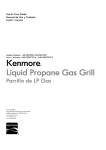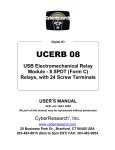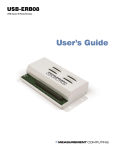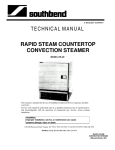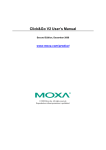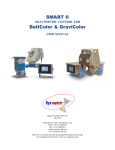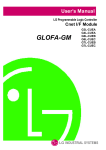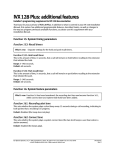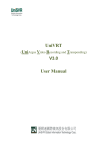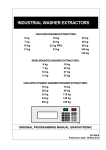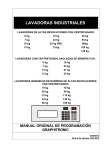Download Series VPH-10000-2 Vaporizer
Transcript
Series VPH-10000-2 Vaporizer Instruction and Operation Manual VPH-10000-2 Rev. 5/7/15 1 Hydro Instruments VPH-10000-2 Vaporizer Table of Contents I.Introduction............................................................................................................. 3 1. Safety Information 2. System Size, Capabilities, and Specifications 3. Units of Measurement II.Installation............................................................................................................... 5 1. Installation of the Vaporizer 2. Installation of Chlorine Pressure Piping 3. Installation of Auxiliary Components 1. Electronic Pressure Reducing Valve 2. Pressure Relief Valve Assembly 3. Expansion Chamber Assembly 4. Electrical Installation 1. Connecting the Main Power 2. Wiring Relays and Alarm Outputs 3. Modbus Information III.Operation............................................................................................................... 14 1. Leak Testing 2. Initial Start-Up 3. System Start 4. System Shut Down 1. Short Term Shut Down 2. Long Term Shut Down 5. Navigating the Controller 1. Explanation of Main Controller Screens 6. Operating Controls and Components 1. Chlorine Gas Temperature Thermocouple 2. Chlorine Gas Pressure Transmitter 3. Water Tank Temperature 4. Water Level Control 5. Water Re-Fill Solenoid 6. Cathodic Protection System 7. Water Heater 7. Alarms and Features IV.Maintenance.......................................................................................................... 23 1. Yearly Maintenance 1. Chlorine Pressure Chamber Cleaning 2. Alarms and Switches Testing 3. Component Preventative Maintenance 2. 5-Year Chlorine Pressure Chamber Cleaning and Inspection V.Troubleshooting.................................................................................................... 26 VI. Important Figures, Parts and Dimensional Drawings 1. Wiring Diagrams....................................................................................... 10-12 2. Assembly Diagrams.................................................................................. 28-30 3. Vapor Pressure Curves............................................................................... 31-33 2 I.Introduction The contents of this manual are intended to provide information regarding the installation, operation, maintenance and troubleshooting of Hydro Instruments’ VPH-10000-2 vaporizer. It is critically important to read and become familiar with the contents of this entire manual before proceeding to install or operate the unit. If you have any questions please consult Hydro Instruments. In certain instances throughout this manual, reference may be made specifically to chlorine. However, the information may also apply to sulfur dioxide and ammonia systems. Please consult with Hydro Instruments if using this product for a chemical other than chlorine. For more information on chlorine safety and handling practices, please refer to the following documents from the Chlorine Institute: The Chlorine Manual, Sixth ed. Washington: The Chlorine Institute, Inc., 2000. Pamphlet 1: Chlorine Basics, Seventh ed. Washington: The Chlorine Institute, Inc., 2008. Pamphlet 6: Piping Systems for Dry Chlorine. Fifteenth ed. Washington: The Chlorine Institute, Inc., 2005. Pamphlet 155: Water and Wastewater Operators Chlorine Handbook, Second ed. Washington: The Chlorine Institute, Inc., 2008. 1.Safety Information Warning • Chlorine is a hazardous chemical that can cause injury and death if not handled properly. It is critically important to take all necessary precautions when handling. This manual is not intended to replace or limit safety procedures in your facility. • Safety procedures must be designed in accordance with all governmental regulations and national safety codes, after giving full consideration to the specific needs of the facility involved. Under no circumstances should the information in this manual be construed as substituting or superseding any local, state, or federal laws and regulations. • Hydro Instruments cannot anticipate the specific safety procedures required at every facility. Accordingly, Hydro Instruments does not guarantee that safety procedures designed in accordance with this manual will completely eliminate hazards and thus assumes no liability for accidents that may occur in your facility. • Read this entire manual and be fully familiar with your equipment and your entire system so that the safety procedures you establish will meet the needs of the employees in you facility. Reading only part of the manual will not help you analyze the needs of your facility. Contact your chlorine supplier, the chlorine institute, and other similar organizations to obtain MSDS sheets and more information. • All information in this manual was current at time of printing. Please note the date of printing and possible obsolescence of material as a result of scientific and medical developments after the date of publication. This applies to all materials you review in the course of developing safety procedures for use at your facility. 3 When working with Chlorine • Ensure that approved, self-contained breathing and safety equipment are always available and ready for use and personnel are properly trained for its use. • Safety equipment should be inspected and maintained in accordance with the manufacturer’s instructions. • Ensure that all warning signs and placards are in their appropriate place and can clearly be displayed. • In the event of a leak, use proper safety equipment and trained personnel to respond to the leak immediately. Evacuate all personnel from dangerous areas to a safe space. If breathing has stopped perform respiration immediately. If heart has stopped perform CPR. • Knowledgeable design personnel should oversee and approve equipment installation and suitability of the system for which it is intended. Qualified personnel should also perform routine equipment checks and maintenance in accordance with manufacturer’s recommendations and instructions. 2.System Size, Capabilities and Specifications Overall height: 64" (163 cm) Clearance space required: 24" (61 cm) on all sides. 12' (3.7 m) floor to ceiling. Chlorine pressure chamber dry weight: roughly 360 lb (163 kg) Water tank dry weight: roughly 430 lb (195 kg) Total assembled dry weight: roughly 790 lb (358 kg) Rated working pressure: 560 psi (38.6 bar) - hydrostatically tested to 825 psi (56.9 bar) Supply pressure: 38 – 210 psi (2.6 – 14.5 bar) Cl2 and SO2 48 – 210 psi (3.3 – 14.5 bar) NH3 Maximum capacity: 10,000 PPD (200 kg/hr) Cl2 8,000 PPD (150 kg/hr) SO2 2,500 PPD (50 kg/hr) NH3 18 kW Maximum heater output: Power consumption: Single phase power: 120 VAC or 240 VAC Three phase power: between 240 VAC (44 A max) and 480 VAC (22 A max) Ambient temperature: 50-122ºF (10-50ºC) Recommended torque for pressure chamber flange bolts: 275 lb-ft (3802 N-m) 3.Units of Measurement 4 For convenience, common measurement values (temperature, pressure, length, mass, torque) will be given in both English and equivalent Metric units. Throughout this manual, pressure values will be shown in units of psi (bar) and denote gauge pressure (zero-referenced against atmospheric pressure.) II.INSTALLATION 1.Installation of the Vaporizer The VPH-10000-2 is supplied completely assembled. The user should install the vaporizer in a location that has at least 12 ft. (3.65 m) of space from floor to ceiling. A lifting crane should also be available at the location and should have a minimum lifting capacity of 2 tons. Additional overhead space should be factored in for the lifting crane. The lifting crane can be used to connect to the two 1" eyebolts located on the top flange to remove the pressure chamber or move the entire vaporizer assembly. To access the eyebolts the user must remove the fiberglass cabinet. Once in position, the vaporizer should be bolted to the floor by the use of four, 5⁄8" concrete anchor bolts through the bottom plate. If installing multiple vaporizers, Hydro Instruments recommends leaving at least 2 feet of clearance space between each vaporizer for ease of access. If using automatic water control, a ½" water pipeline should be installed to the water solenoid valve. The water should have a minimum supply pressure of 15 psi (1 bar) and not exceed 60 psi (4 bar). Drain ports from the vaporizer consist of a 1.5" drain valve, a 1¼" water overflow pipe and a 1 ¼" vent pipe. For convenience all drain pipes are located on the rear side of the unit and must be plumbed on site. Inlet and outlet connections to the vaporizer are made through 1" NPT ammonia type unions. The inlet connection is made through the center of the top flange. Improper installation of the inlet and outlet piping can lead to serious malfunction of the unit and possible personal injury. The liquid chlorine inlet port is on the center of the top flange and the chlorine gas outlet port is off center. For added convenience, the ports are also stamped “IN” for the liquid inlet and “OUT” for the gas outlet. 2.Installation of Chlorine Pressure Piping Connections to the vaporizer are made through the use of 1" ammonia type unions. Chlorine pressure piping should be made of seamless schedule 80 carbon steel, and fittings must be 3000 lb forged type. For more information on chlorine pressure piping and vaporizer piping design tips please see Chlorine Institute’s pamphlet 6 and Hydro Instruments’ Vaporizer Piping Guide EVP-002-CL2. 3.Installation of Auxiliary Components 3.1 Electronic Pressure Reducing Valve The electronic pressure reducing valve is an integral part of any vaporizer system. The electronic pressure reducing valve is the device that will stop chemical feed in the event of an alarm condition. This will prevent liquid chemical from contacting and damaging downstream equipment. Hydro Instruments’ vaporizer allows the user to install two electronic pressure reducing valves into the main controller. One is for operation, and the other for standy-by which can be switched to using the main controller (see Section III.5). The electronic pressure reducing valve must be installed downstream of the vaporizer, after the pressure relief valve assembly and filter but before the vacuum regulator. Available in either 120 VAC or 240 VAC single phase power, the hot wire (black) should be wired into N.O. 1 (CB-8RELAY) and the neutral wire (white) should be wired into the neutral bar in the relay connections box, with the green wire going to ground. If using a second electronic pressure reducing valve use N.O. 5 (CB-8RELAY). Ensure that power is disconnected from the vaporizer before installation. Further information is available through Hydro Instruments’ electronic pressure reducing valve instruction manual. 5 3.2 Pressure Relief Valve Assembly The pressure relief valve assembly is a critical component to any chlorine vaporizer system and is required by ASME code for operation. This mechanical safety device limits the pressure of the chlorine pressure chamber to a maximum value. The rupture disc must be properly installed into the rupture disk holder prior to installing the rupture disk assembly onto the pipe. Installation to the gas pipeline is made through the use of 1" Ammonia type unions. The pressure relief valve assembly should also be installed as close as possible to the vaporizer gas outlet of the pressure chamber. No other interferences can be installed between the outlet of the vaporizer and the rupture disc of this assembly. This assembly must be installed horizontally and in the upright position. Piping coming out of the relief valve must be 1.5" schedule 80 seamless carbon steel and slope downward outside or to another safe location with an insect screen on the outside end. The pressure relief valve assembly also includes a pressure switch that may be wired into the signal output connections box of the vaporizer for Modbus indication of rupture disc failure. It will be wired into the V- and DI4 input terminals. 3.3 Expansion Chamber Assembly The expansion chamber assembly is a mechanical safety device used on liquid chemical lines to prevent pipe rupture in the event of an over pressure condition. Thus, an expansion chamber assembly must be installed everywhere that the liquid has the potential to become trapped in the pipe. This includes sections of pipe that could become isolated through ball valves. In any section of pipe that an expansion chamber is installed on, it must be located at the highest point of this pipe section. The volume of the expansion chamber must also be sized so that its volume is not less than 20% of the pipe volume it is protecting. Supports should also be provided to the expansion chamber assembly. The expansion chamber assembly comes with a pressure switch that may be wired into the signal output connections box of the vaporizer for Modbus indication of rupture disc failure. It will be wired into the V- and DI3 input terminals. 6 4.Electrical Installation 4.1 Connecting the Main Power: The VPH-10000-2 requires three phase power. All power connections are made through the heater control box. Warning: Electrical shock hazard. Ensure all power is disconnected from the source before proceeding. Ensure that only qualified personnel are working on this equipment. a. Turn the single phase power switch off. b. Turn the three phase disconnect switch to the off position. This will allow access to the heater control box. c. Unscrew the four screws on the front of the heater control box. d. Feed the three phase cable and conduit through the 1" conduit fitting on the left side of the heater control box. Ensure fitting is air tight. e. Connect the three phase power into the appropriate terminals (Figure 1a-b). Be sure to tie the ground wire to the ground block. The three phase power is for the heater, which is a delta wiring arrangement and thus no neutral wire is needed. f. Close the heater control box and insert screws. g. Connect power to main source. h. Ensure that the manual contactor override switch is in the enable position. i. Turn the single phase and three phase disconnect switches on. 4.2 Wiring Relays and Alarm Outputs Warning: Electrical shock hazard. Ensure all power is disconnected from the source before proceeding. Ensure that only qualified personnel are working on this equipment. The VPH-10000-2 comes with two pre-wired junction boxes for wiring relays, contacts and 4-20 mA outputs without having to access the main controller. The junction box labeled “Relay Connections” contains the terminals for wiring all the relays and alarm contact outputs. The junction box labeled “Signal Connections” contains the terminals for wiring the 4-20 mA outputs and Modbus communication. The terminal designations can be seen in Table 1 and Table 2. 7 Table 1: Relay Designations for Vaporizer Alarms and Relays Vaporizer Alarm/Relay Board Number Relay Number Recommended Wiring Electronic Pressure Reducing Valve 1 CB-8RELAY 1 N.O. *Refill Solenoid CB-8RELAY 2 N.O. Not used CB-8RELAY 3 - *Magnetic Contactor CB-8RELAY 4 N.O. Electronic Pressure Reducing Valve 2 CB-8RELAY 5 N.O. Superheat Alarm CB-8RELAY 6 N/A High Pressure Alarm CB-8RELAY 7 N/A Water Level Alarm CB-8RELAY 8 N/A Low Water Temperature Alarm CB-2RELAY 1 N/A High Water Temperature Alarm CB-2RELAY 2 N/A * Wired from the factory. Table 2: 4-20 Output Designations Parameter Terminal Range Gas Pressure AO1 0 - 300 psi (21 bar)** Gas Temperature AO2 0 - 121°C (32 - 250°F) Superheat Temperature AO3 0 - 121°C (32 - 250°F) Control Water Temperature AO4 0 - 121°C (32 - 250°F) NOT USED IN MODEL VPH-10000-2 AO5 - Expansion Chamber Switch DI3 closed = alarm Pressure Relief Valve Switch DI4 closed = alarm Note: All outputs must also be wired to the appropriate V- (GND) terminal. **Pressure range can be adjusted but must match the pressure transducer's specifications. 8 4.3 Modbus Information The VPH-10000-2 can communicate with a SCADA system using Modbus RS-485 communication. The baud rate, node number and data format of the VPH-10000-2 must match that of the master SCADA system. See Section III.5 for information on how to access and edit these features. A table of Modbus integers and their corresponding parameters can be seen in Table 3. For more information on configuring Hydro Instruments equipment onto SCADA systems, please refer to the Modbus Installation and Instruction manual. TABLE 3: Modbus Information Name Type Address Gas Temperature Gas Pressure Gas Pressure Span High Pressure Alarm Level Superheat Temperature Superheat Alarm Set Point Control Water Temperature Water Temperature Set Point High Temperature Alarm Set Point Low Temperature Alarm Set Point NOT USED IN MODEL VPH-10000-2 Integer Integer Integer Integer Integer Integer Integer Integer Integer Integer Integer 1 2 3 4 5 6 7 8 9 10 11 Water Level Integer 12 Heater Power Output (kW) Heater Power Output (%) Heater Element Temperature Integer Integer Integer 13 14 15 Temperature Units Integer 16 Pressure Units Integer 17 Alarm Status Integer 18 Register Value Feature 0 1 2 3 Normal High Low Low Low 0 1 0 1 0 2 3 4 5 6 7 8 9 10 Celsius Fahrenheit PSI Bar Normal Low Water Temperature High Water Temperature Heater Over Temperature Superheat Alarm High Water Alarm Low Water Alarm PRV Burst Disc EXP Burst Disc High Pressure 9 Figure 1: Heater Control Box Diagram for Power 3PH Power In 10 MB181 NOT USED PRESSURE RELIEF VALVE PRESSURE SWITCH EXPANSION CHAMBER PRESSURE SWITCH Figure 2: Main Controller Wiring MB122 MB140 MB114 11 Line 1 (Black) Ground (Green) Figure 3: Relay Output Box Connect PRV #1 Here MB108 Line 2 (Red) Solenoid Line 2 Line 2 (Red) PRV #1 Line 2 (Red) Solenoid Not Used Contactor Line 2 (Red) Heater Contactor Optional PRV #2 Superheat Alarm High Pressure Alarm Water Level Alarm MB123 Low Water Temp Alarm High Water Temp Alarm 12 Figure 4: Vaporizer Controller FIGURE 4: Vaporizer Controller MAIN CONTROLLER CATHODIC PROTECTION CONTROL & AMMETER HEATER CONTROL BOX WATER LEVEL INDICATOR THREE PHASE DISCONNECT SWITCH SINGLE PHASE DISCONNECT SWITCH MANUAL CONTACTOR OVERRIDE CONTACTOR INDICATOR STATUS (ON = ENERGIZED) 13 III. Operation 1. Leak Testing Please refer to and follow the leak testing procedure outlined in this section before performing the initial start-up, if the piping has been changed, if the vaporizer has just been cleaned, or for other situations in which air/moisture has been allowed to enter the system. Warning: When performing this step, ensure that all protective equipment is available. Warning: Before beginning the leak test ensure that all appropriate measures have been taken to remove any cutting oils and/or unwanted residue from the piping system. These residues can cause accelerated pipe corrosion and result in a leak. NOTE: Before performing this step, be sure to read Hydro Instruments “Nitrogen Purging” document for further information. a. Individually leak test all expansion chamber assemblies and pressure relief assemblies before beginning this test procedure. Also, test the operation of the pressure switch in each expansion chamber assembly and pressure relief assembly before beginning this procedure. b. Ensure that piping is installed correctly and securely. Also check to ensure that all the chlorine container valves are closed and that no chlorine is in the manifold piping. c. Connect a dry air or nitrogen supply to the end of the chlorine manifold through a ball valve suitable for chlorine manifold service. Make sure that required pressure controls are installed to ensure that the nitrogen or dry air pressure entering the manifold cannot exceed 150 psi (10 bar). d. Purge the system piping with a supply of dry air or nitrogen to remove any moisture or debris (for more information, refer to the Chlorine Institute’s pamphlet 6). e. Once the system has been adequately purged, pressurize the piping to 150 psi (10 bar) using dry air or nitrogen. Then close the air or nitrogen supply valve and record the pressure reading. Watch to ensure that the pressure reading does not drop. Any drop in pressure indicates the presence of a leak that must be identified and corrected before proceeding further. f. Check the entire manifold for leaks using soapy water all the way up to the regulator. If bubbles form there is a leak. The piping must be re-worked and steps d and e must be repeated. g. Lower the nitrogen/dry air pressure to slightly below the chlorine gas pressure, and seal off the nitrogen/dry air connection to the chlorine manifold with a valve or connection that is rated for chlorine manifold service. Then connect the manifold to the chlorine container gas valves (do not connect to the chlorine container liquid valves). Ensure that no moisture has been allowed to enter the system. Close all the valves in the pipeline. h. Open one chlorine gas container valve and its isolation valve and then quickly close them. Check for leaks on the manifold one section at a time using a 26 Baume solution of ammonia. If white smoke appears, there is a leak. If there is a leak, evacuate the system using the ejector and correct the leak. Then repeat steps d through h. Correct all leaks before moving to the next step. i. Open all manifold valves (but, keep the isolation valves and the chlorine container valves closed). Evacuate the system using the ejector. Open one chlorine container gas valve briefly and then close the valves quickly to reintroduce chlorine gas into the system. Then check for leaks one section at a time all the way up to the regulator using a 26 Baume solution of ammonia. j. With the chlorine gas container valves and isolation valves still closed, evacuate the system by operating the ejector until the pressure reads (and holds at) 0 psi (0 bar). 14 2.Initial Start-Up Only refer to the start-up procedure outlined in this section if the previous Section III.1 leak test has already been completed and you are now performing the initial start-up, the piping has been changed, the vaporizer has just been cleaned, or in any other situation in which air/moisture has been allowed to enter the system. Warning: When performing this step, ensure that all protective equipment for handling chlorine gas is available. a. Ensure that piping is installed correctly and securely and the leak test from Section III.1 has already been completed successfully. b. Check to ensure that all the chlorine container valves are closed and that no chlorine is in the piping. c. Turn the vaporizer on (both single phase and three phase power). Immediately the low water alarm will turn on and open the water solenoid valve to allow water into the water tank. At this point also check to see that the low water temperature alarm, and the low superheat alarm are all on (if applicable). d. Once the water has reached operating level, check to see that the alarm condition has cleared and the solenoid valve is completely closed (ensure that no water is coming out of the drain port). e. Check to see that the heater is working by monitoring the water temperature. The factory set operating water temperature of the vaporizer is 180˚F (82˚C). The vaporizer should take 3060 minutes to heat up, depending on incoming water temperature. Check that the low water temperature alarm has turned off once the water temperature has risen to the appropriate set point value. f. Adjust the cathodic protection, using the potentiometer above the ammeter. Operating current should be between 50-250 mA. Add ¼ lb (113 g) of sodium sulphate to increase the conductivity if the requirement cannot be met. Note: Due to the enamel painting of the chlorine pressure chamber, a low/no current reading may appear during the first 6 months of operation. This is normal and the vaporizer is still being protected. g. Connect the manifold to the chlorine container gas valves via flexible connectors/isolation valves. Open the isolation valves connected to each container. Open one chlorine container gas valve and quickly close it again. Check for leaks one section at a time using a 26 Baume solution of ammonia. If white smoke appears, there is a leak. If there is a leak, evacuate the system using the ejector and correct the leak. Then retest the piping to ensure that there are no leaks before proceeding to the next step. h. With the chlorine gas valves closed, evacuate the system by operating the ejector until the pressure transmitter on the vaporizer reads (and holds at) 0 psi (0 bar). Close the isolation valves and connect them to the liquid chlorine header valves. Also close any valves that are in the liquid manifold pipeline. If using multiple ton containers and a gas pressure equalization manifold, then make the connections to this gas pressure equalization manifold and open those valves before opening the liquid chlorine container valves. Open the liquid chlorine header valves, and slowly introduce the liquid chlorine into the system by opening one chlorine container liquid valve at a time. Once all the liquid container valves are open, gradually introduce liquid chlorine into the rest of the manifold by opening the remaining valves one section at a time. Operate the vaporizer at 25% of scale until equilibrium is reached (when temperature and pressure readings are constant over a set period of time). 15 Warning: Ensure that the water tank temperature is 180˚F (82˚C). Liquid chlorine should never be allowed into the vaporizer without the water tank temperature being in the operating range. i. Bring the vaporizer up to 50% and allow the system to reach equilibrium. Do the same at 75% of scale and 100 % of scale. 3.System Start This procedure may only be used after the initial start-up has been completed or if restarting the system and the user is sure that no moisture has been allowed into the system and that no leaks are present. If unsure, use the start-up procedure outlined in Section III.2. Warning: When performing this step, ensure that all protective equipment for handling chlorine gas is available. a. Ensure that the chlorine container valves are closed and there is no chlorine in the piping. Turn on the vaporizer, check to make sure that the water has filled up and the water tank temperature is at operating level. Check that all appropriate alarms have turned off. b. Connect piping to the chlorine gas container valves and allow chlorine gas into the system. Close the gas container valves and check for leaks using a 26 Baume solution of ammonia. If white smoke appears, a leak is present and corrective action must be taken. c. Run the ejector(s) to remove chlorine from the pipeline. Close the isolation valves and connect the manifold to the liquid chlorine container valves. d. Close all valves in the manifold pipeline. Open the isolation valves, and slowly open the liquid chlorine container valves and introduce liquid chlorine into the manifold piping. e. Open the remaining valves one by one until they are all open. f. Operate the vaporizer at 25% of full scale until equilibrium has been reached. Then bring up to 50%, 75% and full scale making sure equilibrium has been established each time (when temperature and pressure readings are constant over a set period of time). Warning: Do not introduce liquid chlorine into the vaporizer without the water tank temperature at operating conditions. 4.System Shut Down 4.1Short Term Shut Down A short term shut down is defined as any situation where the chemical feed is only temporarily interrupted, and the heater and all control functions will remain on. Hydro Instruments recommends the following procedure: a. If applicable, temporarily stop chemical feed at the vacuum regulator and allow liquid to fill back into the container. b. Once equilibrium has been reached (when temperature and pressure readings are constant over a set period of time), shut the liquid & gas chlorine container valves. Keep all manifold valves open. c. Run the ejector to remove all the chlorine from the pipeline until the chlorine pressure reading reads zero. Wait for 30 minutes to ensure pressure readings hold at 0 psi and then repeat this step as necessary. 16 d. Close the isolation valves. Warning: Ensure that the chlorine containers can handle the amount of chemical going back into the container. Overfilled containers will result in a chlorine leak. 4.2Long Term Shut Down A long term shut down is defined as any situation where the chemical feed is going to be stopped and the heater and all control functions will also be shut down. Hydro Instruments recommends the following procedure: a. If applicable, temporarily stop chemical feed at the vacuum regulator and allow liquid to fill back into the container. b. Once equilibrium has been reached (when temperature and pressure readings are constant over a set period of time), shut the liquid & gas chlorine container valves. Keep all manifold valves open. c. Run the ejector to remove all the chlorine from the pipeline until the chlorine pressure gauges read zero. Wait for 30 minutes to ensure pressure readings hold at 0 psi and then repeat this step as necessary. d. Purge the system with dry air or nitrogen according to the instructions in the Hydro Instruments Nitrogen Purging document. Then operate the ejector again to remove all gas from the system until the pressure gauges read zero. e. Close the isolation valves. f. Once established that all the chlorine is evacuated (pressure readings hold at zero), disconnect all power to the vaporizer. Switch to the stand-by unit if necessary. g. Open the drain valve to allow the water in the water tank to drain. Warning: The water and vaporizer components/equipment will be very hot, 180˚F (82˚C), so be careful when handling and/or give the water time to cool before draining. Warning: Ensure that the chlorine containers can handle the amount of chemical going back into the container. Overfilled containers will result in a chlorine leak. 5.Navigating the Controller The vaporizer is provided with a Nema 4x, 2 line alphanumeric display controller that will display and output all important features and conditions. Navigating the controller is done by the use of four push button keys. The push button functions are described below. key: Cycles to the previous screen. key: Cycles to the next screen. key: Increases/changes value. Also used to enter screens key: Decreases/changes value. Note: When adjusting parameter values, the number displayed is automatically saved upon leaving the screen. Thus no “enter” button is needed. Password: All editable features for the VPH-10000-2 are password protected to prevent unwanted tampering with the values. To access these screens the correct password must be entered to proceed. The password for the VPH-10000-2 is “100”. 17 Figure 5: Operating/Configuration Screens Figure 5. Operating/Configuration Screens 18 1 Cl2 T=100F P= 85 psi Superheat = 32 F 12 Select PRV on Duty PRV#1/Relay1 2 Control Water Temp 180 F 13 Modbus Baud=250000 Node=1 Data=8/N/1 3 Heater Power 9.0 kW (50%) 14* Cl2 Pressure Span 300 psi 4 Solenoid = Closed Hold “+” to Open 15* T180 S=180 O=50 E00 G=3.0 I=1.0 LT=5 5 Alarm Status Normal 16* Heater Sheath Temp 300 F 6 Enter Password 100 17* Select Gas Type Cl2 7 Temperature Units =F Pressure Units = psi 8 Water Temp Alarm Low= 160F High= 205F 9 Gas Pressure Alarm 250 psi 10 Super Heat Alm Temp 20F (0 = off) 11 Super Heat Alm Type Non-latching * These menus are referred to as hidden screens and are not visible under normal operation. To access these screens, go to screen 13 and with the node number blinking press and hold the down key until screen 14 appears. The remaining screens may be accessed by pressing the down key after screen 14 appears. 5.1Explanation of Main Controller Screens 1. Operation Screen: This screen displays a live reading of the pressure chamber operating conditions. These parameters include: gas temperature, gas pressure and superheat. 2. Water Temperature: This screen displays a live reading of the water tank temperature. This is the temperature reading that is used for PID control of the water temperature and all appropriate water temperature alarms. 3. NOT USED in Model VPH-10000-2. 4. Heater Power: This screen displays the instantaneous heater power/energy output. The value displayed is based on the 4-20 mA control signal sent to the heater control box. This provides the current energy consumption and provides some indication that chamber/heater cleaning is required due to irregularly high consumption. 5. Solenoid Override: This screen displays the current status of the water refill solenoid (either open or closed). From this screen the solenoid can be overridden from normal operation to open (and fill the water tank) by pressing and holding the key. 6. Alarm Status: This screen displays any alarm conditions that may currently be active, or displays “normal” if no alarm conditions exist. If multiple alarms exist, the controller will cycle all active alarms on this screen every two seconds. For more information on alarm conditions and preventative actions refer to Sections III.7 and V. 7. Password Screen: This screen allows access to all the editable features of the VPH-10000-2. To access the configuration screens the correct password must be entered on this screen. The password for the VPH-10000-2 is “100” and can be entered using the and keys. Once the key to access the remaining screens. correct password is blinking the user may press the 8. Vaporizer Units: This screen allows the user to adjust the operating units used. Temperature values can be displayed in either degrees Fahrenheit (F) or in degrees Celsius (C). Pressure values can be displayed in either psig (psi) or barg (bar). To change units, press the or key until the key. appropriate parameter is blinking, then press the 9. Water Temperature Alarm: This screen allows the user to adjust the high and low water temperature alarm settings. Due to inherent safety and design features the adjustable range of the low water temperature alarm has been set to 160 – 170˚F (71 – 77˚C) and the adjustable range of the high water temperature alarm has been set to 195 – 205˚F (91 – 96˚C). To change values, press the or key until the appropriate parameter is blinking, then press the key to increase or the key to decrease. 10.Gas Pressure Alarm: This screen allows the user to adjust the pressure value above which the gas pressure alarm will activate. This setting has an adjustable range of 250 – 300 psi (17 – 21 bar). To edit this value, press the and keys when this value is blinking until the appropriate value is achieved. 11.Super Heat Alarm Temperature: This screen allows the user to adjust the minimum allowable superheat temperature, below which the alarm and all relevant functions will activate (Section III.7). This value is adjustable from 0 – 50˚F (0 – 27˚C) with “0” disabling the alarm. To edit this value, press the and keys when this value is blinking until the appropriate value is achieved. Recommended superheat alarm values are: 20ºF for chlorine, 30ºF for sulfur dioxide, and 12ºF for ammonia. 19 12. Super Heat Alarm Type: The superheat alarm has the option of either being in the non-latching mode, or completely disabled. If disable is chosen then there will be no alarm indication and the system will not shut down based on a low superheat condition. To change the alarm type, press the key on this screen until the correct type is blinking. 13. Pressure Reducing Valve Duty/Standby Screen: When using two pressure reducing valves in the system one must be designated as the duty (active) pressure reducing valve, with the other inherently in standby. On this screen the user can select whether they want the pressure reducing valve in relay 1 active or the pressure reducing valve on relay 5 active. 14. Modbus: This screen enables the user to adjust the Modbus communication settings to be able to communicate with a SCADA system. Refer to separate “MODBUS Communication Manual” for details. 15. Pressure Range Screen: If desired, a different scale pressure transmitter may be used to monitor pressure. The new span must then be adjusted on this screen to match the incoming 4-20 mA signal. Consult Hydro Instruments before changing pressure ranges or pressure transmitters. 16. PID Control Setting: This screen displays and allows the user to adjust the PID control settings of the vaporizer. The user can adjust the control water temperature set point (S), the gain (G), the integral (I) and the lag time (LT). Live values are also displayed on this screen such as, control water temperature (T), heater output (O), and the integral error (E). 17. Heater Element Sheath Temperature: This screen displays the temperature of the heater elements. It is used for diagnostic purposes only and to trigger disconnection of power to the heater if the temperature rises too high. 18. Gas Type: This screen allows the user to select the chemical feed type depending on the application. Choices are between chlorine (Cl2), sulfur dioxide (SO2), and ammonia (NH3). 20 6. Operating Controls and Components 1. Chlorine Gas Temperature Thermocouple: The chlorine gas outlet temperature is monitored by a K-type thermocouple through the top flange of the chlorine pressure chamber. For added corrosion protection it is installed with a Hastelloy-C thermowell. Its main function is to provide visual indication of the chlorine gas outlet temperature, and together with the chlorine gas pressure transmitter, is used to calculate and then display the superheat value. Should the amount of superheat go below the alarm level, an alarm will be activated to shut down the pressure reducing valve, and thereby prevent liquid chlorine from flooding through the vaporizer. 2. Chlorine Gas Pressure Transmitter: The chlorine gas outlet pressure is monitored by a diaphragm protected pressure transmitter. The scale of the transmitter is 0 – 300 psi (0 – 21 bar). Its main use is to provide visual indication of the chlorine gas pressure in the chlorine pressure chamber, and together with the chlorine gas temperature thermocouple, is used to calculate and then display the superheat value. The operating pressure of the vaporizer should be in the range of 38 – 210 psi (2.6 – 14.5 bar). Should the pressure go outside this range corrective action must be taken (see Troubleshooting). 3. Water Tank Temperature Thermocouple: The water tank temperature is controlled and monitored by one K-type thermocouple. The thermocouple is located in the water tank. The water temperature thermocouple is used for PID control of the heater to maintain a stable water tank temperature of 180˚F (82˚C). It provides the measurements for the low water temperature alarm and high water temperature alarm. 4. Water Level Control: Water level in the water tank can be controlled both automatically and/or manually. For automatic control, there are four conductive level sensors in the water tank (one low level, one low fill, one high fill, and one overfill alarm). Each alarm is then used in conjunction with the water re-fill solenoid to open or close the solenoid and maintain the water level. For manual control, there is a clear glass sight tube on the front panel for the user to determine the operating level. When the sight glass is below 1⁄3 full, water should be added. When the water is above 2⁄3 full water should be stopped. Water may be manually refilled using the 3" through hole on the collar plate, or piping into the existing ½" water re-fill solenoid slot. 5. Water Refill Solenoid: The water refill solenoid is used for automatic control of the water level. It is 2-way, normally closed, Nema 4x rated, with stainless steel housing and is available in either 120 VAC or 240 VAC. Inlet and outlet connections are ½" FNPT. Water supply pressure must be at least 10 psi (0.7 bar) and less than 60 psi (4.1 bar). 6. Cathodic Protection System: Corrosion protection of the chlorine pressure chamber, water tank, water tank piping and all other components is provided by the use of four (4) sacrificial magnesium anodes. The amount of protection provided is adjustable by using the potentiometer next to the ammeter. The amount of current provided should be in the range of 50-250 mA. Any more will unnecessarily consume the anodes and any less will provide insufficient cathodic protection. A ¼ lb (113 g) of sodium sulphate should be added if this amount of current cannot be regularly supplied. Based on normal operating conditions these anodes will be consumed in about one (1) year, and should be replaced yearly. During initial operation little to no current may appear on the controller due to the electrical insulation provided by the enamel painting. This is normal and may take up to 6 months until a reading appears. The vaporizer is still being protected during this period. 7. Water Heater: The water heater is a 4-inch flanged type 18 kW electric heater and includes an over temperature thermocouple to shut off the heater in case of malfunction. The heater will also be shut off by the controller in the case of a low water level or high water temperature alarm. Confirm that the voltage requirements of the heater match that of the incoming three phase power supply before operation. 21 7.Alarms and Features Refer to Table 4 for a description, and action of all alarms incorporated into the vaporizer unit. Note that while some alarms take preventative action themselves, an operator should always monitor an alarm situation and take preventative action if need be or the situation persists. For information on troubleshooting techniques see Section V. The vaporizer controller is equipped with a red LED for alarm indication. All relevant alarms will appear on the alarm screen in two second intervals should multiple alarm conditions exist. Table 4: Vaporizer Alarms Alarm Description Action Taken by Controller Low Superheat The temperature of the outlet gas is less than the alarm value. Shut off the electronic pressure reducing valve until desired superheat is achieved. High Cl2 Pressure Pressure in the chlorine pressure chamber exceeds the alarm value. Shut off the heater. Action must be taken by user to reduce pressure. See troubleshooting. Low Water Temp The water temperature is lower than the alarm value. Shut off pressure reducing valve until desired water temperature is achieved. High Water Temp The water temperature is above the alarm value. Water heater is shut off until water temperature is below the alarm value. Low Water Level Water height is below the minimum operating level. Shut off heater and pressure reducing valve. Open water solenoid until desired water level is achieved. Water Overfill The water level is too close to the tank’s ceiling. None. Action must be taken by user. See troubleshooting. EXP Burst Disc The rupture disc of an expansion chamber None. Action must be taken by user. assembly has blown. Pressure switch must See troubleshooting. be wired into main controller for actuation. PRV Burst Disc The rupture disc of the pressure relief None. Action must be taken by user. assembly has blown. Pressure switch must See troubleshooting. be wired into main controller for actuation. 22 IV. MAINTENANCE 1.Yearly Maintenance 1.1 Chlorine Pressure Chamber Cleaning It is important to inspect and clean the chlorine pressure chamber for signs of corrosion, buildup of debris and clogging. It is recommended to be done on a yearly basis. Ignoring this maintenance step can lead to serious malfunctions of the vaporizer. In some instances it may be cheaper, less time consuming and more reliable to replace the chlorine pressure chamber rather than clean it. The operator should determine this on a case by case basis. Warning: When performing this step, ensure that all protective equipment for handling chlorine gas/liquid is available. a. Refer to Section III.4.2 and complete the long term shutdown, ensuring that all chlorine has been purged from the system. b. Disconnect all power and remove all electrical connections to the top flange and collar plate. Disconnect the inlet and outlet unions. c. Remove the fiberglass cabinet. d. Using a flashlight, inspect the outer surface of the chlorine pressure chamber using the 3" inspection hole in the collar plate. If signs of corrosion exist, proceed to Section IV.2. e. Disconnect the collar plate from the water tank and use the overhead lift to move the inner chamber assembly to a well-ventilated location. f. Remove the top flange of the inner chamber assembly. Using a flashlight, inspect the lead gasket seal areas and the interior of the inner chlorine pressure chamber for corrosion and residue. If signs of corrosion exist, proceed to Section IV.2. g. Using water or appropriate cleaner, purge the internal surfaces of the inner chlorine pressure chamber until all residue has been removed. h. Once clean, inspect again for signs of corrosion. If signs of corrosion exist, proceed to Section IV.2. i. Using a new lead gasket, install the flange onto the chlorine pressure chamber. Be sure to replace any worn or damaged flange nuts or bolts. Torque pressure chamber bolts to 275 lb-ft (3802 N-m). j. Clean water tank and remove any magnesium that may have deposited on the bottom of the water tank. k. Install the chlorine pressure chamber onto the water bath tank with a new rubber gasket and connect the process piping. Be sure to replace any worn or damaged flange nuts or bolts. l. Remove and inspect the heater elements for calcium or other build up that will result in inefficient heat transfer. Clean the elements and heater assembly before re-assembly and replace the heater gasket. m. Re-install all electrical connections/instruments, connect the power, and reconnect the chlorine manifold piping with new lead gaskets. n. Proceed to Sections III.1 and III.2 for leak testing and initial start up to resume chemical feed. 23 1.2. Alarms and Switches Testing Alarms and switches should be tested at least once a year. Before proceeding to perform any testing or maintenance ensure that all chlorine has been completely purged from the system and that the chlorine container valves and inlet manifold piping valves are closed. Please refer to Section III.4.2 for long term system shut down before performing any of the below procedures. After performing any of these procedures, then refer to Sections III.1 and III.2 for leak testing and initial start up to resume chemical feed. Pressure Switch Testing for Relief Valve Assemblies and Expansion Chamber Assemblies a. Remove the pressure switches from the pressure relief and expansion chamber assemblies. b. Apply air pressure at approximately 50 – 100 psi (3 – 7 bar) to each pressure switch to verify operation. c. Replace any pressure switches that fail this testing. d. Install tested pressure switches back into each assembly using an appropriate thread sealant. Chlorine Gas High Pressure Alarm Testing a. Remove the pressure transmitter assembly with diaphragm protector from the inner chlorine chamber top flange. b. Carefully apply nitrogen pressure, slowly increasing to about 300 psi (21 bar), to verify that the high chlorine gas pressure alarm will activate at 250 psi (17 bar) on the vaporizer controller. c. Replace the pressure transmitter assembly if it fails this testing (if the corresponding relay on the controller fails then take corrective action). d. Install tested pressure transmitter assembly with diaphragm protector back onto the top flange of the inner chlorine chamber assembly using an appropriate thread sealant. Pressure Relief Valve a. Remove the Pressure Relief Valve. b. Carefully apply nitrogen pressure, slowly increasing to about 600 psi (41 bar), to verify that the Pressure Relief Valve will open at 560 psi (39 bar). c. Replace the Pressure Relief Valve if it fails this testing. d. Install tested Pressure Relief Valve back onto the assembly. Water Level Alarm Testing a. Turn on the vaporizer unit and allow the water to automatically fill the tank. b. The low water level alarm should be on until the water in the sight glass reaches the low water alarm level marking. c. The solenoid should remain open until the water level in the sight glass reaches the high water fill level marking. Then the solenoid should automatically close. d. If desired, open the drain valve to bring the water level down to the low fill level to verify that the solenoid will then automatically open to start refilling water into the tank. e. If desired, test the water level overfill alarm by manually opening the solenoid valve until the water level in the sight glass reaches the overfill level. At this level, the overfill alarm should activate. 24 Water Tank Temperature Alarm Testing a. Remove the water temperature thermocouple from the water tank flange, leaving the thermocouple extension cable (yellow) connected. b. Place in a bath of room temperature water, allow the sensor to reach equilibrium and check the low water temperature alarm will activate. c. To check the high water temperature alarm, boil water in a separate container. Place the thermocouple in the nearly boiling water (approximately 210ºF / 99ºC) to verify that the high water temperature alarm will activate. d. Reinstall the thermocouple onto the water tank flange. Superheat Alarm Testing The superheat alarm can be tested by placing the chlorine gas temperature probe in ice water during the pressure switch alarm testing. Cathodic Protection Testing At the top of the water tank flange, unfasten the screw and wire connectors from the magnesium anode nearest the ammeter. The current value should then drop to zero. 1.3 Component Preventative Maintenance All rupture discs should be replaced on a yearly basis. O-rings and gaskets should also be replaced yearly or sooner if they appear cracked/damaged in any way. Before proceeding to perform any testing or maintenance ensure that there is no chlorine in the system and that the chlorine inlet piping is shut off. Please refer to Section III.4.2 for system shut down. Magnesium Anode Replacement Based on normal operating conditions, the four (4) sacrificial magnesium anodes will need to be replaced yearly or more often if necessary. This is a very important step as it protects the chlorine pressure chamber and all other system components from corrosion. a. Remove wires connected to the anodes. b. Remove anodes. c. Install new anodes into the respective locations and attach the anode wires. 2.5-Year Chlorine Pressure Chamber Cleaning and Inspection This step should be conducted at least every five years or if signs of corrosion exist. a. Complete Section IV.1.1 chlorine pressure chamber cleaning (perform steps a through h only). b. Weigh the inner chlorine chamber assembly (less the process instrumentation, water tank bolts, anodes and fittings, and inlet/outlet pipe.) and record the weight. c. If the weight of the inner pressure chamber is 10 or more pounds lower than the original weight, or corrosion pits exceed 1⁄8" (0.3 cm) depth anywhere on the chamber, it must be replaced. This weight includes the top flange, flange bolts, and lead gasket. Original weight is stamped on the pressure chamber and also stored with Hydro Instruments for future reference. d. Complete Section IV.1 steps i through n. 25 V. TROUBLESHOOTING: Refer to Table 5 for common problems and troubleshooting techniques for the vaporizer system. For questions please consult Hydro Instruments. Table 5: Troubleshooting Chart Problem Probable Cause(s) Corrective Action • Liquid chlorine in vacuum piping • Demand has exceeded design capacity • Lower capacity to within design flow rate • Damaged vacuum piping and equipment (vacuum regulator) • Fouling of pressure chamber • High pressure in chlorine pressure chamber • Faulty chlorine temperature or pressure sensor did not allow PRV to close • Clean inside and outside of chlorine pressure chamber (follow appropriate shut down and cleaning procedures) • Supply pressure too high • Reduce cylinder pressure • Low water temperature/level and failed switches • Check and replace equipment. • By-pass piping through PRV is open • Check that by-pass piping is not open • Inlet chemical pressure is too high • Lower the room temperature or decrease the amount of gas padding. • Valves closed before and after vaporizer • Open the supply valves • Blockage in supply line • Evacuate and shut down system. Clean/replace piping • Leaking chlorine • Rupture disc has burst due to through pressure relief overpressure valve (pressure switch activated) • Follow long term shutdown to evacuate chemical. Replace rupture disc • Pressure switch activated from expansion chamber assembly • Rupture disc has burst due to entrapment of liquid chlorine • Follow the long term shut down procedure and replace the broken rupture disc • Failed/improperly wired temperature control circuit • Check wiring. Replace equipment if correct • High pressure in liquid pipeline • High water temperature • Failed/improperly wired heater 26 Problem • Low water temperature Probable Cause(s) • Chemical capacity exceeded • Lower feed capacity • Improper wiring/failed heater. Fouling of heater surface • Check wiring/replace or clean heater • Improper wiring/failed temperature controller • Check wiring/replace PID controller • Solenoid is stuck open allowing cold water • Close/replace solenoid. If low water level exists, allow for the water level to reach set point before making any changes • Low water level alarm • Water level is below operating set point • Low water alarm • Pump shut down and heater is shut off Corrective Action • Solenoid failed closed • Check solenoid for correct operation • Check level probes for correct operation • Check for water leaks • Overfill alarm • Water overflowing through drain • Electronic PRV is closed while trying to chlorinate • No cathodic protection • Water level is above operating set point • Solenoid is stuck open. Clean or replace • Solenoid failed open • Replace water level control circuitry • No power to the actuator • Restore power to unit • Alarm condition exists • Check operating parameter and adjust improper conditions • Actuator failed • Inspect and replace actuator • Insufficient conductivity in water • Anodes are consumed • Add ¼ lb. (113 g) sodium sulphate to water • Circuitry improperly connected • Replace anodes • Check circuitry • Low superheat • Design capacity exceeded • Lower feed rate • Fouling inside/outside of pressure chamber • Clean chlorine pressure chamber • Low water temperature • Follow corrective action for low water temperature and/or low water level • Low water level • Corrosion of chlorine pressure chamber • Poor cathodic protection • Check anodes and cathodic protection system • Moisture in manifold piping • Replace chlorine pressure chamber if weight is more than 10 lb (4.5 g) lighter than factory weight or if corrosion anywhere exceeds 1⁄8" (0.3 cm). 27 VI. IMPORTANT FIGURES FIGURE6a: 6a: Vaporizer Vaporizer Parts Figure PartsDiagram Diagram 27 29 30 28 13 14 12 10 11 1 9 2 3 8 4 5 6 8 16 7 22 23 19 15 17 26 23 28 19 24 Figure 6b: Vaporizer Parts List Item No. Hydro Part Number Description Qty. 1 VPH-10000-PT-300 Cl2 pressure transmitter 1 1 VPH-10000-PT-300A NH3 pressure transmitter 1 2 VPH-10000-TC-K-GAS Gas temperature thermocouple, Type K 1 3 VPH-10000-TC-TW Cl2 thermowell 1 3 VPH-10000-TC-TWA NH3 thermowell 1 4 VPH-10000-3 Pressure chamber top flange 1 5 VPH-10000-FB-1 Pressure chamber flange bolts 12 6 VPH-10000-FN-1 Pressure chamber flange nuts 12 7 VPH-10000-MRA Magnesium anode adaptor 4 8 VPH-10000-2-MAG-SET Set of four (4) magnesium anodes 1 9 VPH-10000-000-2 Chlorine pressure chamber (complete assembly) 1 10 VPH-10000-FB2 Water tank flange bolts 8 11 VPH-10000-FN2 Water tank flange nuts 8 12 VPH-10000-002 Water bath flange gasket 1 13 VPH-10000-LE Lifting eyebolts 2 14 VPH-10000-001 Pressure chamber flange gasket 1 15 VPH-10000-003 Level sensor mounting assembly 1 16 VPH-10000-LP Water level sensor 1 17 VPH-10000-PP 3" View port cap 1 19 VPH-10000-2-H-240 Heater, 18kW, 240VAC, 3PH 1 19 VPH-10000-2-H-380 Heater, 18kW, 380VAC, 3PH 1 19 VPH-10000-2-H-480 Heater, 18kW, 480VAC, 3PH 1 22 VPH-10000-MB-2 Floor plate mounting bracket 1 23 VPH-10000-WS-120 Water Refill Solenoid (120 VAC) 1 23 VPH-10000-WS-240 Water Refill Solenoid (240 VAC) 1 24 VPH-10000-Corp-1.5 Stainless steel drain valve 1 26 VPH-10000-000-1 Water Tank (no piping/fittings) 1 27 VPH-10000-CSP-1 Vaporizer inlet pipe 1 28 AH-1642 Vaporizer inlet/outlet union 2 29 VPH-10000-CSP-2 Vaporizer outlet pipe 1 30 VPH-10000-2-TC-K-H2O Water Tank Thermocouple (Type K) 1 29 30 MAIN CONTROLLER MANUAL CONTACTOR OVERRIDE HEATER CONTROL BOX 3 33 8" 848 25" 635 16" 424 11 16 5 10 8" 269 1 47 4" 1200 CATHODIC PROTECTION CONTROL & AMMETER WATER LEVEL PROBE (4 DEPTHS) MAGNESIUM ANODE & ADAPTOR (4 PLACES) 22" 559 VPH-10000-2 (Dimensions) 2015-04-28A Hydro Instruments 1 2 2" 64 CONTACTOR INDICATOR STATUS (ON = ENERGIZED) SINGLE PHASE DISCONNECT SWITCH THREE PHASE DISCONNECT SWITCH WATER LEVEL INDICATOR WATER TEMPERATURE THERMOCOUPLE 8" 203 GAS TEMPERATURE THERMOCOUPLE 3 21 4" 552 MINIMUM DISTANCE TO REMOVE HEATER 5 71 16" 1812 CABINET 22" 559 1 16 4" 413 5" 127 5 17 16" 440 7 22 8" 581 18 KW HEATER 55 8" 1407 3 1 1/4" NPT OVERFLOW 16" 68 11 2 3 3 4" 95 GAS OUTLET 1" AMMONIA TYPE UNION 1/2" NPT SOLENOID LIQUID INLET 1" AMMONIA TYPE UNION 5 95 16" 2422 HEADROOM REQUIRED TO REMOVE GAS CHAMBER 1 1/2" NPT DRAIN 15 5 6 8" 168 5 2 8" 67 3 56 8" 1432 64 16" 1649 WATER REFILL SOLENOID WITH UNION COUPLINGS 3 21 4" 552 MINIMUM DISTANCE TO REMOVE HEATER Figure 7: VPH-10000-2 Dimensional Drawing Figure 6. Chlorine Vapor Pressure Curve Figure 8: Chlorine Vapor Pressure Curve re r po Va su es Pr 31 Figure 7. Sulfur Dioxide Vapor Pressure Curve Figure 9: Sulfur Dioxide Vapor Pressure Curve P or Vap e sur res n. Mi 32 rhe S e up at Figure 8. Ammonia Vapor Pressure Curve Figure 10: Ammonia Vapor Pressure Curve e sur res P r po Va pe . Su at rhe n Mi 33

































